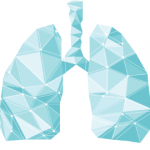
Illnesses involving the lung are among the most common reasons for rheumatology consults in the ICU.
Guschenkova/shutterstock.com
CHICAGO—When it comes to treating patients with rheumatic diseases who are in the intensive care unit (ICU), there are so many complications and considerations that few rules exist as a guide. But Paul Dellaripa, MD, associate professor at Harvard Medical School, said at the ACR’s State-of-the-Art Clinical Symposium that there are basic steps a rheumatologist can take to give themselves the best chance at effective treatment. And he walked through difficult cases to give attendees a sense of his approach.
In some cases, earlier consults and quick action to get a history from a patient before they become unable to help are two ways to try to get a leg up on a tough ICU case.
“It’s important that we ask those acute clinical questions,” he said. “Try to get the patient before they are intubated. … And even when they are intubated, they can still offer you key history and physical exam findings that other people may not have asked.”
According to an informal poll of his colleagues at Brigham and Women’s Hospital, Boston, the main reasons for rheumatology consults in the ICU are vasculitis, interstitial lung disease due to a confirmed or suspected case of connective tissue disease and systemic lupus erythematosus (SLE).
“The problem with understanding how our patients do in the ICU is there’s not a lot of data, and gathering this data can be challenging,” he said.
But according to the small amount of data available, the short answer is: They often don’t do very well. Those with vasculitis in the ICU have been found to have a 39% mortality rate after 31 months of follow-up. And among SLE patients, one 61-patient cohort out of Thailand had a mortality rate of 57%.1,2
Example 1
He recounted the case of a 55-year-old woman who presented with skin lesions and progressive interstitial lung disease. She had been tired recently, with a dry cough, prominent lesions on her forehead and back that were red and slightly raised, and some periungual erythema.
Her aldolase was slightly elevated, her creatinine kinase was normal, but C-reactive protein was high, as expected. Her kidney and liver function were normal.
The woman soon fell into respiratory failure, with an X-ray showing diffuse bilateral infiltrates. Then she developed adenopathy with pulmonary hypertension.

Dr. Dellaripa
The differential diagnosis included pneumonia, hypersensitivity pneumonitis, granulomatous disease, chronic eosinophilic pneumonia and other possibilities, Dr. Dellaripa said.
In this case, he turned his attention to interstitial pneumonia—either idiopathic or usual interstitial pneumonia, non-specific interstitial pneumonia or lymphocytic interstitial pneumonia associated with a systemic disease.
Example 2
Another patient, a 39-year-old man with weakness, dyspnea and elevated CK, showed a radiographic finding with a kind of “rind” of consolidation along the sub-pleural space. Known as the “atoll sign,” this is a mark of organizing pneumonia.
“If you have this [type of] patient and they are not previously immunosuppressed and they have this radiographic finding, this is consistent with organizing pneumonia and would be consistent with their underlying anti-synthetase syndrome,” he said.
Cryptogenic organizing pneumonia is characterized by organizing pneumonia and granulation in the distal airways. It usually responds to steroids, with steroids tapered slowly over six months to a year. It is seen in idiopathic inflammatory myopathy, RA, lupus and systemic scleroderma.
“Always remember that acute onset of what looks like organizing pneumonia in a generally well patient should raise the suspicion of a connective tissue disease,” Dr. Dellaripa said. “And that’s what you need to remind your pulmonary critical-care colleagues.”
Clues to a connective-tissue disease can be found by examining the mouth, skin, nailfold, joints and esophagus.
This patient was ultimately found, on autopsy, to have hyaline membrane disease.
“Unless you can stabilize this [type of] patient and bridge them to transplant, it’s going to be very hard to get a meaningful recovery,” he said.
Other Possibilities
Dr. Dellaripa drew attention to anti-melanoma differentiation-associated protein 5 (MDA5), which can induce production of Type 1 interferon. It can be associated with dermatomyositis, but is often seen in clinically amyopathic cases. The distinguishing traits include ulcerating nodular lesions and calcinosis. It’s important to consider because it can add urgency to a case, he said.
“I think there is a strong suggestion that these patients have a high level of mortality and we need to be aggressive early to try to treat these patients effectively,” he said.
The main reasons for rheumatology consults in the ICU are vasculitis, interstitial lung disease due to a confirmed or suspected case of connective tissue disease & SLE.
He added that, when inflammatory skin lesions and interstitial lung disease are involved, possibilities include inflammatory myositis, SLE, vasculitis and anti-phospholipid syndrome—“and you’re going to have to gear your investigation and consideration for therapy along those lines.”
“When these things are suspected, you need to be called earlier and you need to educate your pulmonary and critical-care colleagues to do so,” Dr. Dellaripa said.
He also touched on the possibility of plasmapheresis in a patient who was ANCA positive and had fallen critically ill.
Even though plasmapheresis is expensive, “it’s certainly a reasonable consideration, although the data up to now is still not very solid. … You have to decide whether to use that as a bridge [while] waiting for your therapies to work.”
Thomas R. Collins is a freelance medical writer based in Florida.
References
- Cruz BA, Ramanoelina J, Mahr A, et al. Prognosis and outcome of 26 patients with systemic necrotizing vasculitis admitted to the intensive care unit. Rheumatology (Oxford). 2003 Oct;42(10):1183–1188.
- Siripaltoon B, Lertwises S, Uea-Areewongsa P, et al. A study of Thai patients with systemic lupus erythematosus in the medical intensive care unit: Epidemiology and predictors of mortality. Lupus. 2015 Jan;24(1):98–106.


